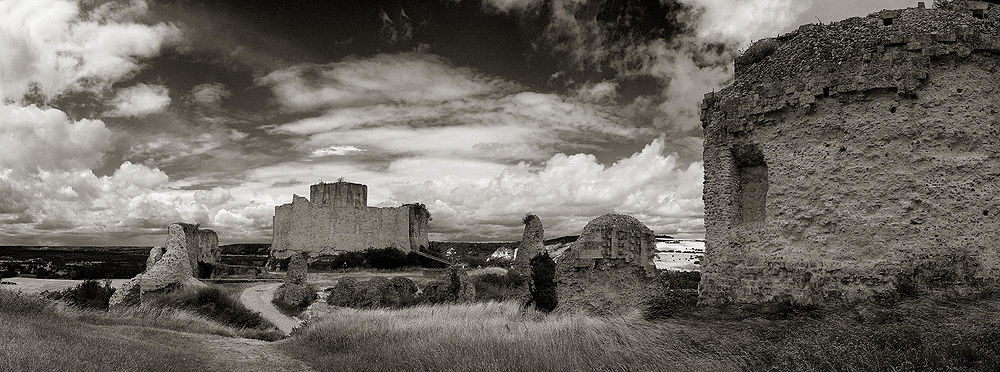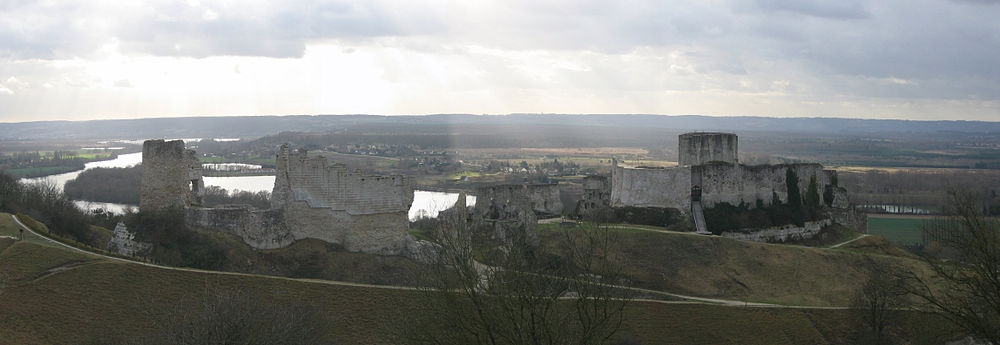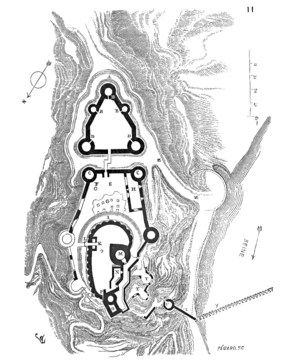- Château Gaillard
-
For the commune in the Ain département, see Château-Gaillard, Ain.
Château Gaillard Les Andelys, France 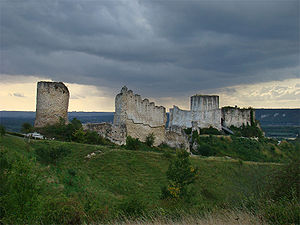
View of Château GaillardType Concentric castle Coordinates 49°14′19″N 1°24′08″E / 49.238611°N 1.402222°ECoordinates: 49°14′19″N 1°24′08″E / 49.238611°N 1.402222°E Built c. 1196–1198 Built by Richard the Lionheart Construction
materialsLimestone Demolished 1599–1611 Current
conditionRuins Commanders  Roger de Lacy
Roger de LacyOccupants  Duchy of Normandy
Duchy of Normandy
 Kingdom of England
Kingdom of England
 Kingdom of France
Kingdom of FranceBattles/wars Siege of Château Gaillard 1203 - 1204 Events Angevin Empire
Hundred Years' WarChâteau Gaillard is a ruined medieval castle, located 90 m above the commune of Les Andelys overlooking the River Seine, in the Eure département of historical Normandy, now Upper Normandy, France. It is located some 95 kilometres (59 mi) north-west of Paris and 40 kilometres (25 mi) from Rouen. Construction began in 1196 under the auspices of Richard the Lionheart, who was simultaneously King of England and feudal Duke of Normandy. The castle was expensive to build, but the majority of the work was done in an unusually short time. It took just two years, and at the same time the town of Petit Andely was constructed. Château Gaillard has a complex and advanced design, and uses early principles of concentric fortification; it was also one of the earliest European castles to use machicolations. The castle consists of three enclosures separated by dry moats, with a keep in the inner enclosure.
Château Gaillard was captured in 1204 by the French king, Philip II, after a lengthy siege. In the mid-14th century, the castle was the residence of the exiled David II of Scotland. The castle changed hands several times in the Hundred Years' War, but in 1449 the French captured Château Gaillard from the English for the last time, and from then on it remained in French ownership. Henry IV of France ordered the demolition of Château Gaillard in 1599; although it was in ruins at the time, it was felt to be a threat to the security of the local population. The castle ruins are listed as a monument historique by the French Ministry of Culture. The inner bailey is open to the public from March to November, and the outer baileys are open all year.
Contents
History
Background
 A 17th-century portrait of Richard the Lionheart, the man responsible for building Château Gaillard.
A 17th-century portrait of Richard the Lionheart, the man responsible for building Château Gaillard.
Richard the Lionheart inherited Normandy from his father, Henry II, in 1189 when he ascended to the throne of England. There was rivalry between the French king and Richard as the King of England was more powerful than the King of France, despite the fact that Richard was a vassal of the French king and paid homage for his lands in the country.[1] From 1190 to 1192, Richard the Lionheart was on the Third Crusade. He was joined by Philip II of France as each was wary that the other might invade his territory in his absence.[2] Richard was captured and imprisoned on the return journey to England, and he was not released until 4 February 1194. In Richard's absence, his brother John revolted with the aid of Philip; amongst Philip's conquests in the period of Richard's imprisonment was Normandy. It took Richard until 1198 to reconquer Normandy.[3]
Construction
Perched high above the River Seine, an important transport route, the site of Château Gaillard, in the manor of Andeli, was identified as a naturally defensible position.[4] In the valley below the site was the town of Grand Andely.[5] Under the terms of the Peace of Louviers (December 1195) between Richard and Philip II neither king was allowed to fortify the site; despite this, Richard intended to build a castle at Andeli.[4] Its purpose was to protect the duchy of Normandy from Philip II[6]—it helped fill a gap in the Norman defences left by the fall of Château de Gisors and was 7.4 miles (11.9 km) away from Château de Gaillon, a castle which belonged to Philip—and to act as a base from which Richard could launch his campaign to take back the Norman Vexin from French control.[7] Richard tried to obtain the manor through negotiation. Walter de Coutances, Archbishop of Rouen, was reluctant to sell the manor as it was one of the diocese's most profitable, and other lands belonging to the diocese had recently been damaged by war.[4] When Philip besieged Aumale in Normandy, Richard grew tired of waiting and seized the manor,[4][8] although the act was opposed by the Church.[9]
In an attempt to get Pope Celestine III to intercede, Walter de Coutances left for Rome in November 1196. Richard sent a delegation to represent him in Rome. One of the party, Richard's Lord Chancellor William Longchamp (who was also Bishop of Ely), died during the journey, although the rest, including the Philip of Poitou, Bishop of Durham, and Guillaume de Ruffière, Bishop of Lisieux, arrived in Rome.[10] Walter de Coutances meanwhile issued an interdict against the duchy of Normandy which prohibited church services from being performed in the region. Roger of Howden detailed "the unburied bodies of the dead lying in the streets and square of the cities of Normandy". Construction began with the interdict hanging over Normandy, but it was later repealed in April 1197 by Celestine, after Richard made gifts of land to the Walter de Coutances and the diocese of Rouen, including two manors and the prosperous port of Dieppe.[11][12] The site of Château Gaillard had not been fortified before, and the town of Petit Andely was constructed at the same time; together with Grand Andely, the two are known as Les Andelys.[5][13] The castle sits on a high limestone promontory, 90 m above Les Andelys and overlooking a bend in the River Seine. The castle was connected with Andelys through a series of contemporary outworks.[11]
 The keep of Château Gaillard is surrounded by a moat.
The keep of Château Gaillard is surrounded by a moat.
During Richard's reign, the Crown's expenditure on castles declined from the levels spent by Henry II, Richard's father, although this has been attributed to a concentration of resources on Richard's war with the king of France.[14] However, the work at Château Gaillard cost an estimated £15,000 to £20,000 between 1196 and 1198.[15] This was more than double Richard's spending on castles in England, an estimated £7,000.[16] The Pipe rolls for the construction of Château Gaillard contain the earliest details of how work was organised in castle building and what activities were involved. Amongst those workmen mentioned in the rolls are quarrymen, masons, carpenters, smiths, soldiers to guard the workers, diggers who cut the ditch surrounding the castle, and carters who transported the raw materials to the castle. A master-mason is omitted, and military historian Allen Brown has suggested that it may be because Richard himself was the overall architect; this is supported by the interest Richard showed in the work through his frequent presence.[6]
Not only was the castle built at considerable expense, but it was built relatively rapidly;[13] construction of large stone castles often took the best part of a decade; for instance the work at Dover Castle took place between 1112 and 1191 (at a cost of £7,000).[17] Richard was present during part of the construction to ensure construction proceeded at a rate he was happy with.[18] According to William of Newburgh, in May 1198 Richard and the labourers working on the castle were drenched in a "rain of blood". While some of his advisers thought the rain was an evil omen, Richard was undeterred:[19]
the king was not moved by this to slacken one whit the pace of work, in which he took such keen pleasure that, unless I am mistaken, even if an angel had descended from heaven to urge its abandonment he would have been roundly cursed.—William of Newburgh[20]After just a year, Château Gaillard was approaching completion and Richard remarked "Behold, how fair is this year-old daughter of mine!"[6] Richard later boasted that he could hold the castle "were the walls made of butter".[21] By 1198, the castle was largely completed.[6] At one point, the castle was the site of the execution of three French soldiers in retaliation for a massacre of Welsh mercenaries ambushed by the French; the three were thrown to their deaths from the castle's position high above the surrounding landscape.[22] In his final years, the castle became Richard's favourite residence, and writs and charters were written at Château Gaillard, bearing "apud Bellum Castrum de Rupe" (at the Fair Castle of the Rock).[13] Richard did not enjoy the benefits of the castle for long, however, as he died in Limousin on 6 April 1199, from an infected arrow wound to his shoulder, sustained while besieging Châlus.[23][24]
The Siege of Château Gaillard
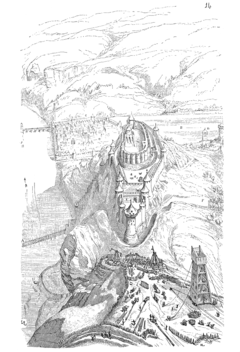 An impression by Eugène Viollet-le-Duc, a 19th-century architect experienced in renovating castles, of how the Siege of Château Gaillard would have looked
An impression by Eugène Viollet-le-Duc, a 19th-century architect experienced in renovating castles, of how the Siege of Château Gaillard would have looked Main article: The Siege of Château Gaillard
Main article: The Siege of Château GaillardAfter Richard's death, King John of England failed to effectively defend Normandy against Philip's ongoing campaigns between 1202 and 1204.[25] Château de Falaise fell to Philip's forces, as well as castles from Mortain to Pontorson while Philip simultaneously besieged Rouen,[26] which capitulated to French forces on 24 June 1204, effectively ending Norman independence.[27] Philip laid siege to Château Gaillard, which was captured after a long siege from September 1203 to March 1204. As Philip continued the siege throughout the winter and King John made no attempt to relieve the castle, it was only a matter of time before the castellan was forced to capitulate.[28] The main source for the siege is Philippidos, a poem by William the Breton, Philip's chaplain. As a result, modern scholars have paid little attention to the fate of the civilians of Les Andelys during the siege.[22]
The local population sought refuge in the castle to escape the French soldiers who ravaged the town. The castle was well supplied for a siege, but the extra mouths to feed rapidly diminished them; between 1,400 and 2,200 non-combatants were allowed inside, increasing the number of people in the castle at least fivefold. In an effort to alleviate the pressure on the castle's supplies, Roger de Lacy, the castellan, evicted 500 civilians; this first group was allowed to pass through the French lines unhindered, and a second group of similar size did the same a few days later. Philip was not present, and when he learned of the safe passage of the civilians, he forbade further people being released from the castle. The idea was to keep as many people within Château Gaillard to drain its resources.[22] Roger de Lacy evicted the remaining civilians from the castle, at least 400 people, and possibly as many as 1,200. The group was not allowed through, and the French opened fire on the civilians. They turned back to the castle for safety, but found the gates locked. They sought refuge at the base of the castle walls for three months; over the winter, more than half their number died from exposure and starvation. Philip arrived at Château Gaillard in February 1204, and ordered that the survivors should be fed and released. Such treatment of civilians in sieges was not uncommon, and such scenes were repeated much later at the sieges of Calais in 1346 and Rouen in 1418–1419, both in the Hundred Year's War.[22]
The French gained access to the outermost ward by undermining one of the towers. Following this, Philip ordered a group of his men to look for a weak point in the castle. They gained access to the next ward when a soldier named Ralph found a latrine chute in use through which the French could clamber into the chapel.[29] After ambushing several unsuspecting guards, and setting fire to the buildings, Philip's men then lowered the drawbridge[dubious ] and allowed the rest of their army into the castle. The Anglo-Norman troops retreated to the inner ward.[28] After a short time the French successfully breached the gate of the inner ward, and the garrison retreated finally to the keep. With supplies running low Roger de Lacy and his garrison of 20 knights and 120 other soldiers surrendered to the French army, bringing to an end the siege on 6 March 1204.[28] In drawn-out medieval sieges, contemporary writers often emphasised the importance of dwindling supplies in the capitulation of the garrison, as was the case with the Siege of Château Gaillard.[30] With the castle under French control, the main obstacle to the French entering the Seine valley was removed; they were able to enter the valley unmolested and take Normandy. Thus, for the first time since it had been given as a duchy to Rollo in 911, Normandy was directly ruled by the French king.[31] The city of Rouen surrendered to Philip II on 23 June 1204.[32] After that, the rest of Normandy was easily conquered by the French.[31]
Under French control
In 1314, Château Gaillard was the prison of Margaret of Burgundy and Blanche of Artois, two French noblewomen; they were locked up and had their heads shaved for committing adultery.[33] Following the Scottish defeat at the Battle of Halidon Hill in 1333 during the Second War of Scottish Independence, the child-king David II and certain of his court were forced to flee to France for safety. At the time, southern Scotland was occupied by the forces of King Edward III of England. David, then nine years old, and his bride Joan of the Tower, the twelve-year-old daughter of Edward II, were granted the use of Château Gaillard by Philip VI. It remained their residence until David's return to Scotland in 1341. David did not stay out of English hands for long after his return; he was captured after the Battle of Neville's Cross in 1346 and endured an eleven-year captivity in the Tower of London.[34]
During the Hundred Years' War between the English and French crowns, possession of the castle switched several times. Château Gaillard—along with Château de Gisors, Château de La Roche-Guyon, Ivry-la-Bataille, and Mont-Saint-Michel—was one of five castles in the Normandy which offered resistance to Henry V of England in 1419, after the capitulation of Rouen and much of the rest of the Duchy. Château Gaillard was besieged for a year before it was surrendered to the English in December 1419;[35] all the resisting castles except Mont-Saint-Michel eventually fell, and Normandy was temporarily returned to English control.[36] Étienne de Vignolles, a mercenary (routier) known as La Hire, then re-captured Château Gaillard for the French in 1430.[37] However, the English were revived by the capture and execution of Joan of Arc, and although by then the war was turning against them, a month later they captured Château Gaillard again.[38] When the French gained ascendency again between 1449 and 1453 the English were forced out of the region,[39] and in 1449 the castle was taken by the French for the last time.[40]
By 1573, Château Gaillard was uninhabited and in a ruinous state, but it was still believed that the castle posed a threat to the local population if it was repaired. Therefore, at the request of the French States-General, King Henry IV ordered the demolition of Château Gaillard in 1599.[40][41] Some of the building material was reused by Capuchin monks who were granted permission to use the stone for maintaining their monasteries. In 1611, the demolition of Château Gaillard came to an end. The site was left as a ruin, and in 1862 was classified as a monument historique.[40] In 1962, a conference on the contributions of the Normans to medieval military architecture was held at Les Andelys. Allen Brown attended the conference and remarked that the castle was "in satisfying receipt of skilful care and attention". The journal Château Gaillard: Études de Castellogie Médiévale, which was published as a result of the conference, has since run to 23 volumes, based on international conferences on the subject of castles.[42][43] In the 1990s, archaeological excavations were carried out at Château Gaillard. The excavations investigated the north of the fortress, searching for an entrance postulated by architect Eugène Viollet-le-Duc, but no such entrance was found. However, the excavation did reveal was that there was an addition to the north of the castle to enable the use of guns. Typologically, the structure has been dated to the 16th century. The conclusion of the excavations was that the site had "enormous archaeological potential", but that there were still unanswered questions about the castle. After Philip II took Chateau Gaillard, he repaired the collapsed tower of the outer bailey that had been used to gain access to the castle. The archaeological investigation examined the tower generally thought to be the one collapsed by Philip, and although it did not recover any dating evidence, the consensus is that he completely rebuilt the tower. In conjunction with the archaeological work, efforts were made to preserve the remaining structures.[41] Today, Château Gaillard's inner bailey is open to the public from March to November, while the outer baileys are open all year round.[40]
Layout and innovations
Château Gaillard consists of three baileys—an inner, a middle, and an outer with the main entrance to the castle—and a keep, also called a donjon, in the inner-bailey. The baileys, which were separated by rock-cut ditches,[13] housed the castle's stables, workshops, and storage facilities.[44] It is common for extant castles to be the result of several phases of construction, and were adapted and added to over the period of their use; however Château Gaillard essentially is the result of one period of building.[19]
The outer bailey is the southernmost feature of the castle; it is pentagon shaped and there are five towers spaced along the wall, three of which are at corners. North of the outer bailey is the middle bailey which is an irregular polygon; like the outer bailey, the wall of the middle bailey is studded with towers. The towers allowed the garrison to provide enfilading fire. In the fashion of the time, most of the towers in the curtain walls of the middle and outer baileys were cylindrical.[13] Château Gaillard was one of the first castles in Europe to use machicolations—stone projections on top of a wall with openings that allowed objects to be dropped on an enemy at the base of the wall.[45][46] Machicolations were introduced to Western architecture as a result of the Crusades. Until the 13th century, the tops of towers in European castles had usually been surrounded by wooden galleries, which served the same same purpose as machicolations. An Eastern innovation, they may have originated in the first half of the 8th century.[47]
Within the middle bailey was the inner bailey. The gatehouse from the middle to the inner-bailey was one of the earliest examples of towers flanking the entrance to remove the blind-spot immediately in front of the gate.[48] This was part of a wider trend from around the late 12th or 13th century onwards for castle gateways to be strongly defended.[49]
The design of the inner bailey, with its wall studded with semi-circular projections, is unparalleled.[13] This innovation had two advantages: firstly, the rounded wall absorbed the damage from siege engines much better as it did not provide a perfect angle to aim at; secondly, the arrowslits in the curved wall allowed arrows to be fired at all angles.[50][51] The inner bailey, which contained the main residential buildings, used the principles of concentric defence.[52] This and the unusual design of the inner bailey's curtain wall meant that castle was advanced for its age, since it was built before concentric fortification was fully developed in Crusader castles such as Krak des Chevaliers.[13][52] Concentric castles were widely copied across Europe; for instance when Edward I of England—who had himself been on Crusade—built castles in Wales in the late 13th century, four of the eight he founded were concentric.[52][53]
The keep was inside the inner bailey and contained the king's accommodation.[13] It had two rooms: an antechamber and an audience room. While Allen Brown interpreted the audience room as the king's chamber, historian Liddiard believes it is probably a throne room. A throne room emphasises the political importance of the castle.[54] In England there is nothing similar to Château Gaillard's keep, but there are buildings with a similar design in France in the 12th and 13th centuries.[55]
Allen Brown described Château Gaillard as "one of the finest castles in Europe"[13] and military historian Sir Charles Oman wrote that:
Château Gaillard, as we have already had occasion to mention, was considered the masterpiece of its time. The reputation of its builder, Coeur de Lion, as a great military engineer might stand firm on this single structure. He was no mere copyist of the models he had seen in the East, but introduced many original details of his own invention into the stronghold.—Oman 1924[50]Despite Château Gaillard's reputation as a great fortress, Liddiard highlights the absence of a well inside the castle as a peculiar weakness, and the castle was built on soft chalk, which would have allowed the walls to be undermined. This is attributed to Château Gaillard being important not solely as a military structure, but as a salient symbol of the power of Richard the Lionheart. It was a statement of dominance by Richard, having reconquered the lands Philip II had taken.[54] Castles such as Château Gaillard in France, and Dover in England, were amongst the most advanced of their age, but were surpassed in both sophistication and cost by the works of Edward I of England in the latter half of the 13th century.[6]
See also
References
- Notes
- ^ Flori 1999, pp. 27–28.
- ^ Gillingham 2002, p. 123.
- ^ Gillingham 2004.
- ^ a b c d Gillingham 2002, p. 301.
- ^ a b Holbach 1912, p. 297.
- ^ a b c d e Allen Brown 2004, p. 113.
- ^ Gillingham 2002, pp. 303–305.
- ^ Turner 1997, p. 10.
- ^ Packard 1922, p. 20.
- ^ Gillingham 2002, pp. 301–302.
- ^ a b Gillingham 2002, pp. 302–304
- ^ Allen Brown 2004, p. 112.
- ^ a b c d e f g h i Allen Brown 2004, p. 62.
- ^ Allen Brown 1955, pp. 355–356.
- ^ McNeill 1992, p. 42.
- ^ Gillingham 2002, p. 304.
- ^ McNeill 1992, pp. 41–42.
- ^ Liddiard 2005, pp. 42–43.
- ^ a b Gillingham 2002, p. 303.
- ^ Quoted by Liddiard 2005, pp. 112–113.
- ^ Oman 1991, p. 32.
- ^ a b c d McGlynn 1998
- ^ Flori 1999, pp. 200, 208.
- ^ Gillingham 2002, pp. 323–325.
- ^ Turner 1993, pp. 171–200.
- ^ Powicke 1999, p. 259.
- ^ Previté-Orton 1975, p. 708.
- ^ a b c Oman 1991, p. 37.
- ^ Cummins 2007, p. 160
- ^ Allen Brown 2004, p. 139.
- ^ a b Baldwin 1969, p. 1.
- ^ Cothren 1986, pp. 211–212.
- ^ Caviness 1993, pp. 334–336.
- ^ Webster 2004
- ^ Allmand 1997, p. 130.
- ^ Burne 1976, pp. 133–134.
- ^ Allmand 1988, p. 76.
- ^ Burne 1976, p. 272.
- ^ Curry 2003, p. 96.
- ^ a b c d (PDF) Château Gaillard, Tourism office of Ville Andelys, http://office-tourisme.ville-andelys.fr/upload/Images/Plaquette_GB_21-04-09.pdf, retrieved 2009-12-21
- ^ a b (in French) Andelys (Les): Château Gaillard, adlfi.fr, http://www.adlfi.fr/SiteAdfi/document?base=base_notices&id=N2004-NH-0002&q=sdx_q0&recherche=listDoc&req=Ch%C3%82teau%20Gaillard&typ=notices, retrieved 2009-12-21
- ^ Allen Brown 1962–63, p. 304.
- ^ The Castle Studies Group – New Publications: New Books on Castles to be published during 2008-9, The Castle Studies Group, http://www.castlestudiesgroup.org.uk/page16.html, retrieved 2009-12-21
- ^ Friar 2003, p. 22.
- ^ Friar 2003, p. 32.
- ^ Creswell 1953, p. 3.
- ^ Cathcart King 1988, pp. 84–87.
- ^ Allen Brown 2004, pp. 62, 64.
- ^ Cathcart King 1988, pp. 77–78.
- ^ a b Oman 1991, p. 33.
- ^ Friar 2003, pp. 124–125.
- ^ a b c Friar 2003, p. 77.
- ^ Cathcart King 1988, p. 83.
- ^ a b Liddiard 2005, p. 54.
- ^ Allen Brown 2004, p. 54.
- Bibliography
- Allen Brown, R (1955), "Royal Castle-Building in England, 1154–1216", The English Historical Review (Oxford University Press) 70 (276): 353–398
- Allen Brown, R (1962–63), "Conference on castles at Les Andelys, 1962", Medieval Archaeology 6–7: 304
- Allen Brown, R (2004) [1954], Allen Brown's English Castles, Woodbridge: The Boydell Press, ISBN 1843830698
- Allmand, C (1988), The Hundred Years War: England and France at War, c. 1300–c. 1450, Cambridge University Press, ISBN 9780521319232
- Allmand, C (1997), Henry V, Yale University Press, ISBN 978-0300073706
- Baldwin, John (1969), "Philip Augustus and the Norman Church", French Historical Studies (Duke University Press) 6 (1): 1–30
- Burne, Alfred Higgins Burne (1976), The Agincourt War: A Military History of the Latter Part of the Hundred Years War, from 1369 to 1453, Taylor & Francis, ISBN 9780837183008
- Cathcart King, David James (1988), The Castle in England and Wales: an Interpretative History, London: Croom Helm, ISBN 0-918400-08-2
- Caviness, Madeline (1993), "Patron or Matron? A Capetian Bride and a Vade Mecum for Her Marriage Bed", Speculum (Medieval Academy of America) 68 (2): 333–362
- Cothren, Michael, "The Seven Sleepers and the Seven Kneelers: Prolegomena to a Study of the "Belles Verrières" of the Cathedral of Rouen", Gesta (International Center of Medieval Art) 25 (2): 203–226
- Creswell, K (1953), "Problems in Islamic Architecture", The Art Bulletin (College Art Association) 35 (1): 1–7
- Cummins, Joseph (2007), Turn around and run like hell: amazing stories of unconventional military strategies that worked, Murdoch Books, ISBN 9781921208645
- Curry, Anne (2003), The Hundred Years War, Palgrave Macmillan, ISBN 9781403908162
- Flori, Jean (1999), Richard the Lionheart: Knight and King, Edinburgh: Edinburgh University Press, ISBN 978-0-7486-2047-0
- Friar, Stephen (2003), The Sutton Companion to Castles, Stroud: Sutton Publishing, ISBN 978-0-7509-3994-2
- Gillingham, John (2002) [1999], Richard I, London: Yale University Press, ISBN 0-300-09404-3
- Gillingham, John (2004), "Richard I (1157–1199), king of England" (Subscription or UK public library membership required), Oxford Dictionary of National Biography, Oxford: Oxford University Press, http://www.oxforddnb.com/view/article/23498, retrieved 2009-12-22
- Holbach, Maude (1912), In the Footsteps of Richard Coeur de Lion, Kessinger Publishing, http://books.google.co.uk/books?id=yMjCFqgbRboC&dq=%22Grand+Andelys%22&lr=&as_brr=3&client=firefox-a&source=gbs_navlinks_s
- Hooper, Nicholas; Bennett, Matthew (1996), The Cambridge Illustrated Atlas of Warfare: The Middle Ages, 768–1487, Cambridge University Press, ISBN 978-0521440493
- Liddiard, Robert (2005), Castles in Context: Power, Symbolism and Landscape, 1066 to 1500, Macclesfield: Windgather Press Ltd, ISBN 0-9545575-2-2
- McGlynn, Sean (1 June 1998), Useless Mouths, 48, History Today
- McNeill, Tom (1992), English Heritage Book of Castles, London: English Heritage and B. T. Batsford, ISBN 0-7134-7025-9
- Oman, Charles (1991) [1924], A History of the Art of War in the Middle Ages, Volume Two: 1278–1485 AD, Greenhill Books
- Packard, Sydney (1922), "King John and the Norman Church", The Harvard Theological Review (Cambridge University Press) 15 (1): 15–40
- Powicke, Maurice (1999) [1913], Loss of Normandy, 1198–1204, Manchester University Press, ISBN 978-0719057403
- Previté-Orton, Charles William (1975), The Shorter Cambridge Medieval History, Cambridge: Cambridge University Press, ISBN 9780521099776, http://books.google.co.uk/books?id=53I5AAAAIAAJ&dq=Rouen+Normandy+%2224+June%22+1204+Philip&source=gbs_navlinks_s
- Turner, Ralph (September 1993), "King John's military reputation reconsidered", Journal of Medieval History 19 (3): 171–200
- Turner, Ralph (1997), "Richard Lionheart and English Episcopal Elections", Albion: A Quarterly Journal Concerned with British Studies (The North American Conference on British Studies) 29 (1): 1–13
- Webster, Bruce (2004), "David II (1324–1371), king of Scots" (Subscription or UK public library membership required), Oxford Dictionary of National Biography, http://www.oxforddnb.com/view/article/3726, retrieved 2009-12-22
Further reading
- Dieulafoy, Marcel (1898) (in French), Le Château Gaillard et l'architecture militaire au XIIIe siècles, Paris: Klincksieck
- Héliot, Pierre (1962), "Le Château Gaillard et les fortresses des XIIe et XIIIe siècles" (in French), Château Gaillard 1: 53–75
External links
- Medieval History of Navarre.- Château Gaillard and the Queen of Navarre
- French Ministry of Culture database entries for Château Gaillard:
- The castle, Inventory notice (French)
- The site (French)
- Château Gaillard, history and pictures (French)
Categories:- Châteaux in France
- Official historical monuments of France
- 12th-century architecture
- Landmarks in France
- Buildings and structures in Eure
Wikimedia Foundation. 2010.


